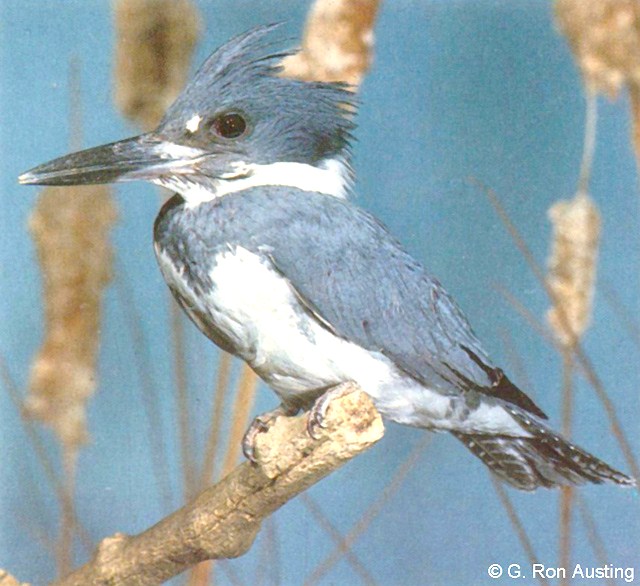The Belted Kingfisher is deserving of its name, as it is an expert fisherman. While searching for prey, the kingfisher will perch in a favored spot, or hover over the water's surface. It will dive headfirst after a fish or other prey it has spotted. Parents teach their fledglings how to hunt by dropping dead prey in the water for the young to retrieve.
Length: 28 - 33 cm.
Physical characteristics:
This is a medium-sized kingfisher, with a large head and a very long, stout bill. The tail and legs are relatively short. Both sexes have a bushy crest, blue upperparts, and a blue-gray band across the breast - on otherwise white underparts. The female also has a chestnut stripe on the lower breast and flanks.
Voice:
Song is an extended percussive rattle.
Breeding habitat:
This species is always found near water (fresh or salt water), such as lakes, streams, ponds and estuaries. It prefers clear water with unobstructed views.
Mating system:
Seasonally monogamous; one brood is raised per year.
Nest:
The nest is a long tunnel or burrow in the sand or dirt bank of a stream or lake. A pair may also nest in ditches, landfills and sand or gravel pits. The dome-shaped nest chamber at the end of the tunnel is normally unlined. The tunnel averages 1 - 2 meters (3 - 6 feet) in length and is excavated by both sexes.
Eggs:
Commonly 6-7 white, unmarked eggs are laid in one clutch. 34mm (1.4″).
Chick development:
The eggs are incubated by both sexes for 22-24 days. (The male usually incubates in the afternoon; the female at night.) The chicks are altricial at hatching. They fledge at 27-29 days of age. The young may be cared for from 1 to 3 weeks postfledging, after which they are driven from their parents' territory.
Diet:
The diet of the Belted Kingfisher consists of mostly small fish. It will also occasionally take amphibians, insects, aquatic invertebrates, reptiles, young birds and small mammals. This bird perches or flies over the water, diving in when prey is sighted. It takes the fish to a perch, stuns the fish by pounding it on the perch, then swallows it head first. It will regurgitate pellets of bones and scales. The young are fed on regurgitant until they can consume whole prey.
Parasites:
None of the three kingfishers examined showed positive for blood parasites (haematozoa).
Belted Kingfishers are widespread, but they have been poorly studied. Population numbers may have declined slightly in recent years, but this is uncertain. The availability of nesting sites and the quality of water are important factors with reference to kingfisher populations. The Belted Kingfisher does not appear to be adversely affected by environmental contaminants, probably because the small fish it eats do not accumulate as many toxins as larger fish do.
In Park: The Belted Kingfisher is a fairly common year-round resident bird species in the Park. In the Smokies, this species is most likely to be observed near Fontana Lake, but may be found near other water ways as well. In a survey of breeding birds in the park, performed from 1996-1999, 17 Belted Kingfishers were observed during the breeding season.
References:
Alsop, F. J. III. 1991. Birds Of The Smokies. Great Smoky Mountains History Association, Gatlinburg, Tennessee.
Bent, A. C. and Collaborators. 1996 - 2002. Belted Kingfisher, In Life Histories of Familiar North American Birds, ed., Patricia Query Newforth.
Committee on Classification and Nomenclature of the American Ornithologists' Union. 2000. Forty-second supplement to the American Ornithologists' Union Check-list of North American Birds. The Auk 117: 847-858.
Ehrlich, P. R., D. S. Dobkin, and D. Wheye. 1988. The Birder's Handbook: a Field Guide to the Natural History of North American Birds. Simon and Schuster, Inc., New York.
Elphick, C., J. B. Dunning, Jr., and D. A. Sibley, eds. 2001. The Sibley Guide to Bird Life and Behavior. Alfred A. Knopf, New York.
Gough, G. A., Sauer, J. R., Iliff, M. Patuxent Bird Identification Infocenter. 1998. Version 97.1. Patuxent Wildlife Research Center, Laurel, MD. http://www.mbr-pwrc.usgs.gov/id/framlst/infocenter.html.
Hamas, M. J. 1994. Belted Kingfisher (Ceryle alcyon). In The Birds of North America, No. 84 (A. Poole and F. Gill, Eds.). Philadelphia: The Academy of Natural Sciences; Washington, DC: The American Ornithologists? Union.
Sibley, D. A. 2000. The Sibley Guide to Birds. Alfred A. Knopf, New York.
Stupka, A. 1963. Notes on the Birds of the Great Smoky Mountains National Park. University of Tennessee Press.
Animalia
Chordata
Aves
Coraciiformes
Alcedinidae
Phenology

